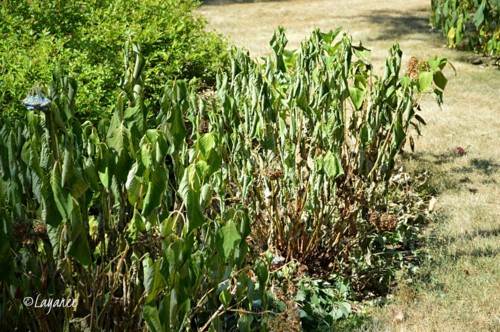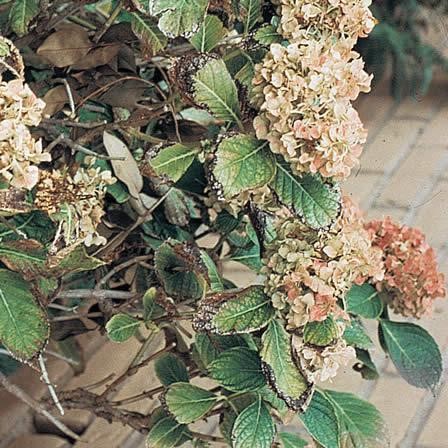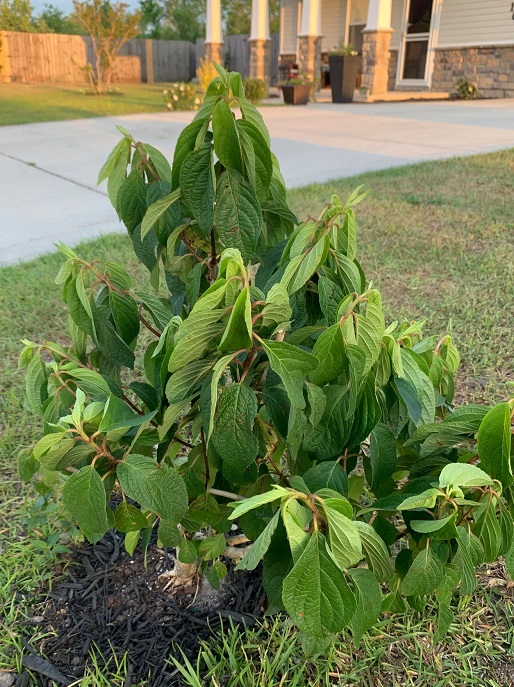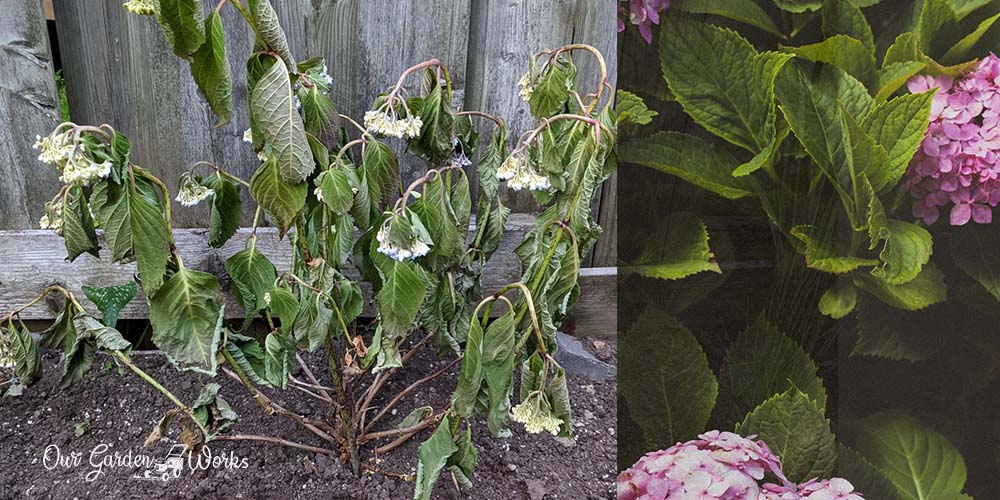Hydrangea leaves wilting or drooping is the most common way hydrangeas express their discomfort or stress.
As heat-sensitive and moist-loving plants, any changes to their environment can cause them stress. But the thing with plant stress is there can be a lot of causes that require different solutions.
In this post, we will help you figure out what your hydrangeas are trying to tell you through their wilting leaves.
We will also share some ways on how you can improve their health and prevent further plant health decline.
5 Cause of hydrangea leaves wilting or drooping & how to fix them
While heavy infestation is the immediate theory of most gardeners, factors like sun exposure, moisture levels, and transplant shock are more likely to cause the wilting.
Check each condition below and have a better understanding of how you can help your hydrangeas perk up again.
#1 Drought stress
Hydrangeas are one of the first plants to show signs of drought stress when there’s a heat wave.
Their leaves become droopy and if they are left unwatered, they may die out of extreme drought.
In their natural habitat, they are tucked under the canopy of trees in woodlands, which gives them the cool temperature and moist soil that they need.
Some heat-tolerant varieties, like big-leaf hydrangeas, may withstand a bit of heat but they’ll need frequent watering to compensate for the moisture loss on their leaves.

If they don’t get enough moisture from the roots, the leaves will start to wilt and show other signs of stress like:
- Dropping green leaves.
- Stunted growth.
- Dropping crispy dry leaves.
Though drought stress is common to plants, it is particularly lethal to hydrangeas. If you suspect that drought is the cause of wilting in your hydrangeas, treat them immediately to ensure that the stems will not thoroughly dry out.
How do you revive wilted hydrangeas due to drought stress?
Drought-stressed hydrangeas with stems that still bends and do not crack can still be treated. It means that there’s still a bit of moisture circulating around the plant to support its parts.
Here’s how you can treat your surviving hydrangeas:
- If the hydrangeas are placed in direct sun, move them in areas with partial shade.
- Water the dehydrated hydrangeas for 10 to 15 minutes 3 to 4 times a week. You will notice that the leaves will start to perk up after a few hours. However, that doesn’t mean that the plants are no longer in a state of stress.
- When there’s new growth, you may gradually decrease the watering routine.
- Sadly, the wilted leaves will no longer green up and slowly die on their own. You may opt on removing the wilted leaves to help the hydrangeas conserve their energy and divert all their resources on developing new leaves.
- The last step to maintain the vigor of your revived hydrangeas is adding mulch on the soil. Mulch will help with moisture retention and keep the soil temperature cool during the day, which hydrangeas love.
The most ideal materials to use as mulch on hydrangeas are natural materials that decompose and serve as fertilizers later on, such as:
How to know if hydrangeas can no longer be saved
Not all drought-stressed hydrangeas can recover from drought stress.
As we’ve mentioned earlier in this post, excessive drought can kill hydrangeas. When the plant veins on the stem have dried up, there’s no chance to revive the hydrangea back to health.
The best way to know if you still have a chance to save your hydrangeas is to bend the stem. If it’s still bendy and doesn’t crack easily, you still have a chance.
However, if it’s as crisp as a dry leaf, then, the plant has already seen better days and has succumbed to extreme dehydration.
#2 Overfertilization: High nitrogen fertilizer
Too much love can kill your hydrangeas, especially when it is fed with too much nitrogen. They will have a higher chance to survive from starving nutrients than being overfertilized.
Proper timing is also crucial for hydrangeas to avoid bearing tender stems during winter. The signs of overfertilization are:
- Scorched leaf tips.
- Wilting leaves.
- Sudden death of the plant.
Nitrogen, in particular, is a nutrient that promotes vegetative growth in hydrangeas. Oftentimes, the nitrogen fertilizer applied on lawns leaks into the plant beds of hydrangeas that pushes them to grow thin stems.
When the flowers start to develop, the stem is too weak to handle the weight of the blooms which pushes them to flop over.
Here are some considerations in fertilizing your hydrangeas to prevent overfertilization and flopping stems:
(1) Timing: The best time to fertilize hydrangeas is during the peak of their growth in May and July.
You should avoid fertilizing them in August to prevent developing new growth that will not survive the winter season.
Hydrangeas are also preparing for dormancy in August, which will only waste your fertilizer. In the northern regions, it’s best to apply fertilizers once in either June or July.
(2) Amount: Ideally hydrangea in the ground will require more fertilizer than those in containers.
Before applying anything to the soil make sure that the soil pH level is on the right track. Hydrangea thrives in an acidic environment with soil pH levels of 6.0 to 6.2.
If the pH is beyond that range, the roots will fail to absorb the nutrients from the soil. Use a soil pH meter and base the soil treatment on the results. If the soil is too acidic, you may add agricultural lime in the soil or sulfur if it’s too alkaline.
Once the soil pH level is at the right level, you may observe how your hydrangeas react to the change in the soil. If there’s no improvement, you may start fertilizing them in an adequate amount.
Usually, store-bought fertilizers have packaging labels that have application instructions for potted and in-ground hydrangeas. You may follow those but if there are no instructions, you may use these measurements as a guide:
- Young in-ground hydrangeas: ⅛ to ¼ cup of granulated fertilizer.
- Big and mature in-ground hydrangeas: 2 to 3 cups of granulated fertilizer.
Pro tip: Apply fertilizers on the drip line of hydrangeas. The drip line is the farthest reach of their roots underground. Avoid applying fertilizer near the stem to avoid chemical burns on the roots. Also, sick and dying hydrangeas should not be fertilized to avoid stressing them even further.
#3 Too much sun
While hydrangeas love being tucked away from the scorching afternoon sun, they still need direct sun for a short time in temperatures around 50℉ to 60℉.

However, their safety against heat stress and sun damage depends on the hydrangea variety and the climate. Here’s a regional guide for appropriate sun exposure for hydrangeas:
- US Hardiness Zones 5 to 7: Hydrangeas can be exposed to full sun in the morning and partial shade in the afternoon.
- US Hardiness Zones 8 to 9: Partial shade throughout the day.
The weather should be cold enough to prevent hydrangeas from getting heat-stressed. That’s why some hydrangeas flourish in direct sun in spring and fall where the weather compensates for the heat from the sun.
Some hydrangeas are also more heat-tolerant than others which allows gardeners in tropical and subtropical areas to grow them. These include:
- Panicle hydrangea.
- Quercifolia hydrangea.
- Bigleaf hydrangea.
- Pinky Winky hydrangea.
- Limelight hydrangea.
- Quickfire hydrangea.
Due to climate change, some regions are experiencing unusual heat waves that greatly affect hydrangeas in colder regions. Their poor plants not only show wilting leaves but also plant injuries like bleached and short-lived blooms and extremely dry leaves and stems.
Hydrangeas are cold-loving shrubs since their natural habitat is under the canopy of trees in the woodlands.
Observe the sun exposure of your sick hydrangeas, as it might be the main reason why it’s not developing any leaves, growing tall, or producing flowers.
How to treat heat-stressed hydrangea
Hydrangeas have their emergency system that activates when it experiences too much sun exposure.
Their first attempt would be curling the leaves by reducing the exposure of the leaf surface to the harsh sun to keep them cool and save them from further moisture loss.
If left untreated, stressed hydrangeas will start to wilt and experience a downward spiral of plant health decline.
To save your stressed hydrangeas, here are some steps that you can try:
Deep watering
Extremely dehydrated hydrangeas will need deep watering to keep their parts from drying.
Though hand pouring and sprinkler system works, experts recommend a soaker hose for better plant hydration. It is a type of watering system that gradually releases droplets of water on the drip zone of your hydrangeas.
Avoid maintenance pruning and feeding
The saddest part with heat and drought-stressed hydrangeas is their inability to produce blooms during that growing season. They will be pushing all their energy for restoring their plant health instead of developing blooms or seeds.
Excessive pruning and feeding will only stress recovering hydrangeas so better delay them once the plant has fully recovered.
To keep hydrangeas tidy and help them conserve energy, you may remove the spent leaves and flowers. However, avoid cutting stems for the time being.
Mulching
Mulching helps with soil moisture and temperature retention. It will also prevent weeds from sprouting around your hydrangeas.
Ideally, it’s best to use acidic mulch, like pine materials including pine bark or pine straw.
Pest and disease control
Hydrangeas under stress are at their most vulnerable stage and can be easily targeted by pests and fungal diseases.
Protect your recovering hydrangeas and spray them with maintenance insecticidal soap and fungicide. Keep applying them until the hydrangeas are 100% recovered and produce healthy leaves and vibrant flowers.
#4 Transplant shock

Almost any plant can suffer from transplant shock but it is more evident in mature hydrangeas that have been growing in the same pot or location for a long time.
Hydrangea leaves wilting after repotting is more likely caused by transplant shock, even stunted growth and smaller leaf size.
Transplant shock in hydrangeas usually takes around 3 to 4 weeks. However, if there are root injuries, the recovery can take longer than usual. There’s no treatment for transplant shock.
All you can do is maintain an ideal growing environment for your hydrangeas. Keep them fed and watered and tucked in partial shade until they fully adapt to their new environment.
#5 Pest damage or fungal disease
Healthy hydrangeas don’t easily succumb to pest damage. However, a heavy infestation can cause moisture loss on the leaves leading to wilting. Common culprits of leaf damage are sap-sucking insects, such as:
- Scales.
- Aphids.
- Slugs.
- Beetles.
When the plant is weakened by pests or any environmental stress, they become a magnet for fungal diseases such as Cercospora leaf spot and anthracnose. Poor air ventilation within the shrub can also cause moisture accumulation leading to fungal disease development.
Though hydrangeas are not as sickly as other plants, they still need routine pest and disease management. Check out our specific post about the best fungicide for hydrangeas here.
Frequently Asked Questions(FAQs)
Can you bring a dead hydrangea back to life?
No, once a hydrangea has dried out with stems that snap when bent, they are no longer viable for revival. You still have a slim chance to revive it if the stems still contain some moisture in them.
To test this, the stem must be bendable enough which means the fibers still contain water.
Is it normal for hydrangeas to wilt in the heat?
Yes, hydrangeas are cold-loving plants. They can’t withstand heat without the help of increased watering.
If you live in the warm regions of the US, better choose a hydrangea variety that’s more heat-tolerant like the panicle or big leaf.
Final Thoughts
Hydrangea leaves wilting and drooping are a sad sight to witness, especially if you’ve tried to give all your might to care for them. Such conditions are normal for plants to encounter throughout their life. As long as you know where to check and identify the problem, you’ll easily help restore the health of your hydrangeas.
We hope that this post helped you diagnose the problem and easily give your hydrangeas the right treatment.
The best thing about well-informed gardeners is they no longer need to waste so much time doing trial and error to help their plants.
As the saying goes, you have so much leverage in anything if you‘re well-informed and ripened by experience.
Let us know in the comments about your experience in treating your hydrangeas! Also, please share these with your friends who love hydrangeas and help them become better gardeners.
